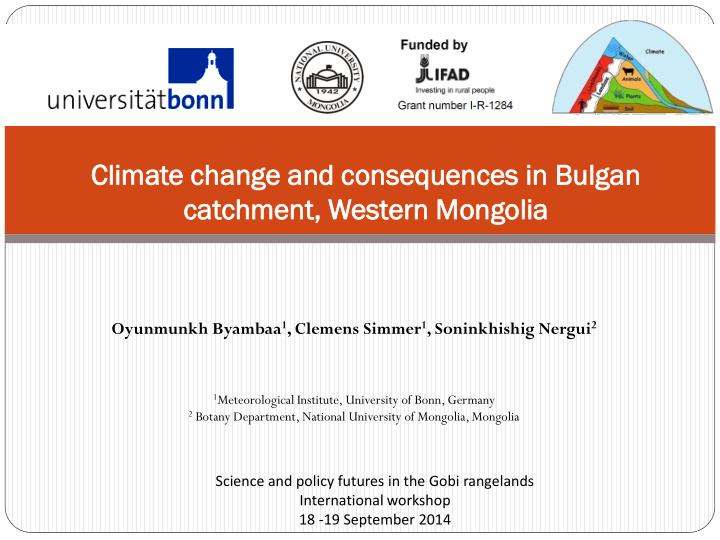



Cli limat mate e change nge and d conseq sequences uences in Bulgan gan catch tchment ment, , West stern rn Mongoli olia Oyunmunkh Byambaa 1 , Clemens Simmer 1 , Soninkhishig Nergui 2 1 Meteorological Institute, University of Bonn, Germany 2 Botany Department, National University of Mongolia, Mongolia Science and policy futures in the Gobi rangelands International workshop 18 -19 September 2014
WATERCOPE project Support national research capacity and policy to cope with dwindling water resources and intensifying land use in the transborder Altay-Dzungarian region of Mongolia and China • Resource dependent • Local knowledge about characteristics of change • Complain about climate change • Question from us “How climate change will impact on river water level and pasture in the future”
Difference of instrumental data and perception station data represents specific herders provide personal parameters in valley feeling of mixed parameters and spatial data due to their seasonal movements
Goal and objectives To understand effect of global warming on local climate variability and change • Instrumental data analysis • Use of local people’s perception as key • to learn more • To select appropriate climate model for future scenarios • to explain future changes in easy way
Previous studies: Local people’s knowledge about climate change
Stud tudy y area ea Altay-Dzungarian region Altitude: • max- 4087 m • mean – 2300 m Characterization: • High mountains • Arid/ semi desert • Glacier • Permafrost • River originates from snow and ice melting (50-70%) and rainfall 5-10%
Questionnaire on local knowledge about hydro-climate change • Stratified random sampling • herders/ farmers above 40 age • 10 herders/farmers per bag (town) • 5 bags per soum (region) • Questionnaires • 100 local people • 7 local government officers • Structure of questionnaire A. Climate change B. Water resource change C. Weather forecast service
Climate change in Bulgan catchment Duchinjil station, 1951 m Baitag station, 1181 m Annual mean temperature change in high mountainous area Annual mean temperature in Gobi desert area 3 2 2.5 Difference from 1963-2011, ºC 1.5 2 Difference from 1977-2011, ºC 1 1.5 0.5 1 0 0.5 0 -0.5 -0.5 -1 -1 -1.5 -1.5 -2 -2 -2.5 -2.5 -3 -3 1977 1982 1987 1992 1997 2002 2007 1963 1968 1973 1978 1983 1988 1993 1998 2003 2008 Annual mean precipitation at Duchinjil station Annual mean precipitation at Baitag station 250 y = 0.9565x + 112.2 250 y = 0.6748x + 60.15 R² = 0.086 200 R² = 0.0779 200 150 mm 150 mm 100 100 50 50 0 0 1977 1979 1981 1983 1985 1987 1989 1991 1993 1995 1997 1999 2001 2003 2005 2007 2009 2011 1963 1966 1969 1972 1975 1978 1981 1984 1987 1990 1993 1996 1999 2002 2005 2008 2011
Climate indices
Changes in air temperature and precipitation Preciptation at Baitag station Precipitation at Duchinjil station 45 45 P, mm P, mm 40 40 1963-1969 1980-1989 1970-1979 35 1990-1999 35 1980-1989 2000-2011 1990-1999 30 30 2000-2011 25 25 20 20 15 15 10 10 5 5 0 0 Jan Feb Mar Apr May Jun Jul Aug Sep Oct Nov Dec Jan Feb Mar Apr May Jun Jul Aug Sep Oct Nov Dec Months Months
Changes in seasons Windspeed at Baitag station Windspeed at Duchinjil station 1 0.8 Difference from 1963-2011, m/s Difference from 1977-2011, m/s 0.8 0.6 0.4 0.6 0.2 0.4 0 0.2 -0.2 0 -0.4 -0.2 -0.6 -0.4 -0.8 -1 -0.6 1977 1982 1987 1992 1997 2002 2007 1963 1968 1973 1978 1983 1988 1993 1998 2003 2008
Extreme events
Discussion and Conclusion Perception about air temperature can be caused by wind Increase of wind speed – part of variability Summer rain delay in Gobi Desert (A.Marin) More drought than previous decades
Thank you for attention
Recommend
More recommend